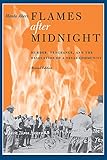Flames after Midnight : Murder, Vengeance, and the Desolation of a Texas Community, Revised Edition / Monte Akers.
Material type: TextPublisher: Austin : University of Texas Press, [2021]Copyright date: ©2011Description: 1 online resource (286 p.)Content type:
TextPublisher: Austin : University of Texas Press, [2021]Copyright date: ©2011Description: 1 online resource (286 p.)Content type: - 9780292729926
- 972/.0099
- F394.K57 A4 2011
- F394.K57 A4 2011
- online - DeGruyter
| Item type | Current library | Call number | URL | Status | Notes | Barcode | |
|---|---|---|---|---|---|---|---|
 eBook
eBook
|
Biblioteca "Angelicum" Pont. Univ. S.Tommaso d'Aquino Nuvola online | online - DeGruyter (Browse shelf(Opens below)) | Online access | Not for loan (Accesso limitato) | Accesso per gli utenti autorizzati / Access for authorized users | (dgr)9780292729926 |
Frontmatter -- Contents -- Acknowledgments -- PART ONE -- Prologue to Part One -- CHAPTER 1 Eula -- CHAPTER 2 Kirven, the County, the Country, and the Kings -- CHAPTER 3 The Instant when Music Shatters Glass -- CHAPTER 4 Sheriff Mayo -- CHAPTER 5 Manhunt -- CHAPTER 6 A "Good Job" in the Early Hours of the Morning -- CHAPTER 7 This Cold World of Care -- CHAPTER 8 Terror -- PART TWO -- Prologue to Part Two -- CHAPTER 9 A Visitor from Waco -- CHAPTER 10 Confirmation -- CHAPTER 11 Doll Rags -- CHAPTER 12 Greater Irony -- CHAPTER 13 A Place in Blackest History -- CHAPTER 14 Burning Questions -- CHAPTER 15 Epilogue: A Notoriety Deeply to be Regretted -- CHAPTER 16 Epilogue to the Revised Edition -- Notes -- Index -- Index to the Epilogue, Revised Edition
restricted access online access with authorization star
http://purl.org/coar/access_right/c_16ec
What happened in Kirven, Texas, in May 1922, has been forgotten by the outside world. It was a coworker's whispered words, "Kirven is where they burned the [Negroes]," that set Monte Akers to work at discovering the true story behind a young white woman's brutal murder and the burning alive of three black men who were almost certainly innocent of it. This was followed by a month-long reign of terror as white men killed blacks while local authorities concealed the real identity of the white probable murderers and allowed them to go free. Writing nonfiction with the skill of a novelist, Akers paints a vivid portrait of a community desolated by race hatred and its own refusal to face hard truths. He sets this tragedy within the story of a region prospering from an oil boom but plagued by lawlessness, and traces the lynching's repercussions down the decades to the present day. In the new epilogue, Akers adds details that have come to light as a result of the book's publication, including an eyewitness account of the burnings from an elderly man who claimed to have castrated two of the men before they were lynched.
Mode of access: Internet via World Wide Web.
In English.
Description based on online resource; title from PDF title page (publisher's Web site, viewed 26. Apr 2022)


